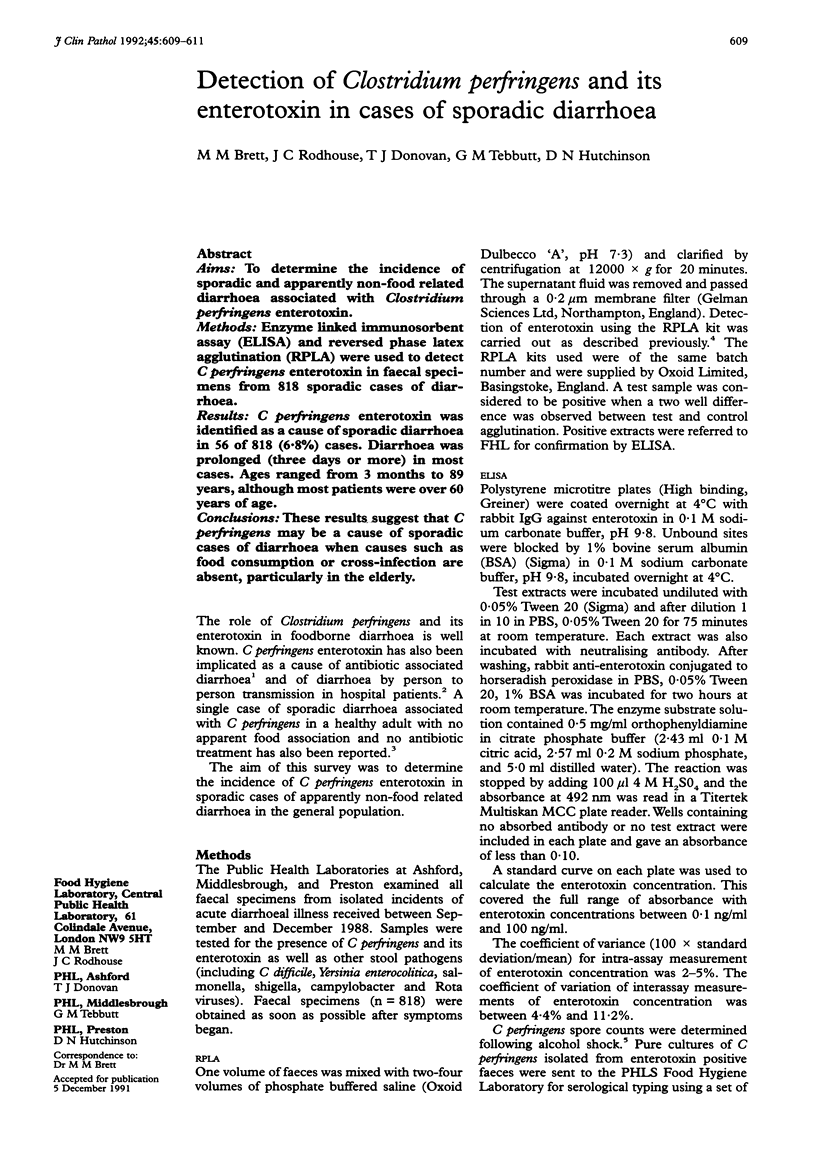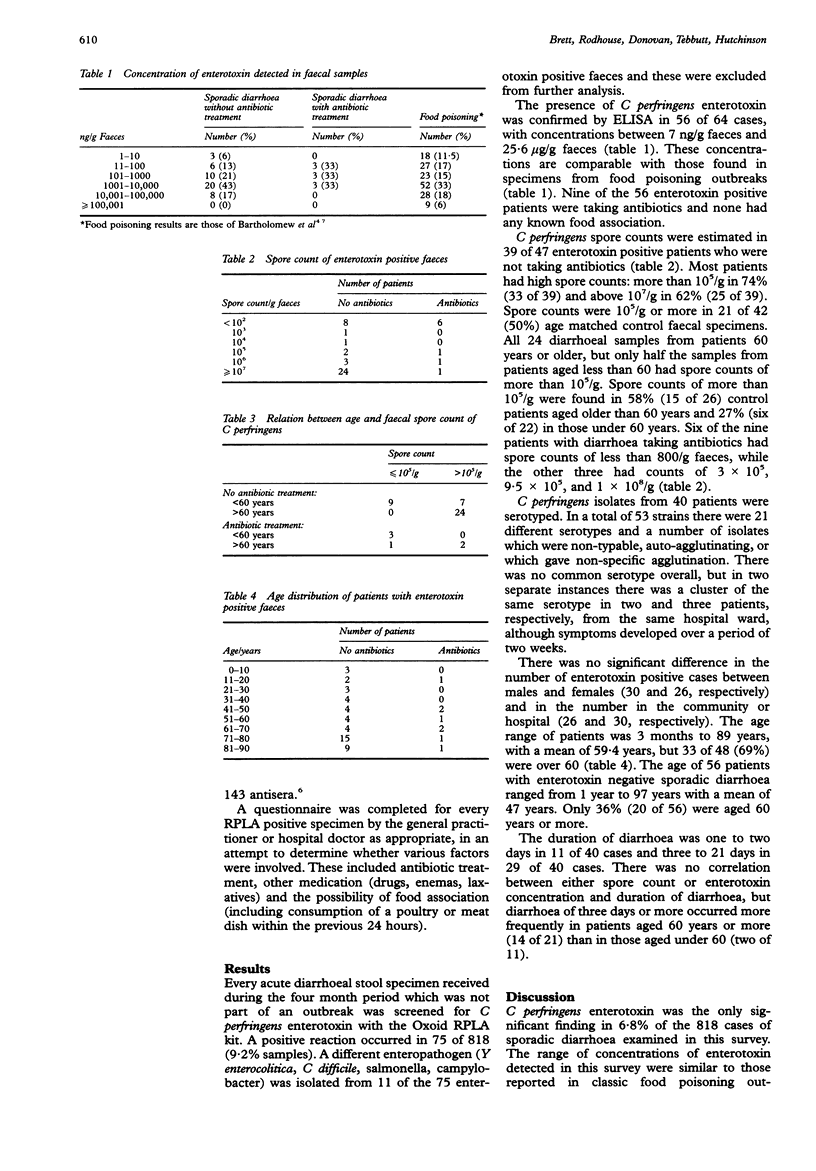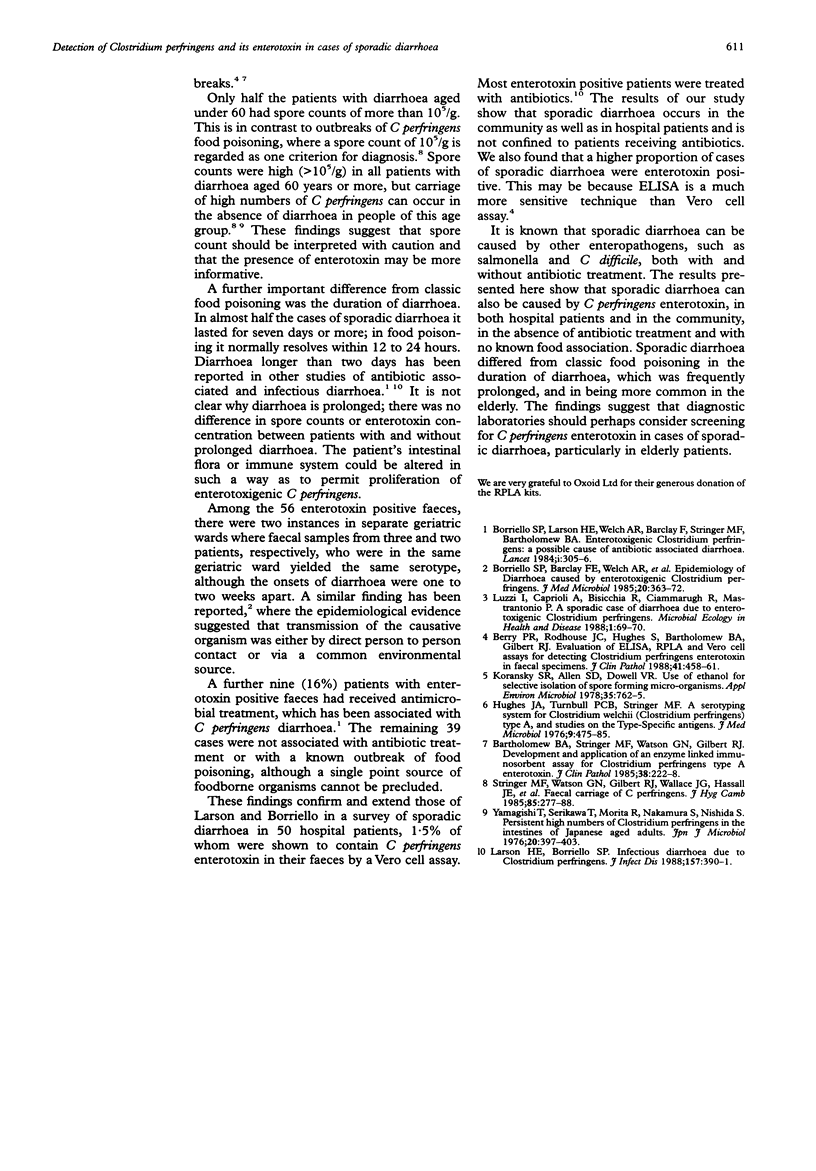Abstract
AIMS: To determine the incidence of sporadic and apparently non-food related diarrhoea associated with Clostridium perfringens enterotoxin. METHODS: Enzyme linked immunosorbent assay (ELISA) and reversed phase latex agglutination (RPLA) were used to detect C perfringens enterotoxin in faecal specimens from 818 sporadic cases of diarrhoea. RESULTS: C perfringens enterotoxin was identified as a cause of sporadic diarrhoea in 56 of 818 (6.8%) cases. Diarrhoea was prolonged (three days or more) in most cases. Ages ranged from 3 months to 89 years, although most patients were over 60 years of age. CONCLUSIONS: These results suggest that C perfringens may be a cause of sporadic cases of diarrhoea when causes such as food consumption or cross-infection are absent, particularly in the elderly.
Full text
PDF


Selected References
These references are in PubMed. This may not be the complete list of references from this article.
- Bartholomew B. A., Stringer M. F., Watson G. N., Gilbert R. J. Development and application of an enzyme linked immunosorbent assay for Clostridium perfringens type A enterotoxin. J Clin Pathol. 1985 Feb;38(2):222–228. doi: 10.1136/jcp.38.2.222. [DOI] [PMC free article] [PubMed] [Google Scholar]
- Berry P. R., Rodhouse J. C., Hughes S., Bartholomew B. A., Gilbert R. J. Evaluation of ELISA, RPLA, and Vero cell assays for detecting Clostridium perfringens enterotoxin in faecal specimens. J Clin Pathol. 1988 Apr;41(4):458–461. doi: 10.1136/jcp.41.4.458. [DOI] [PMC free article] [PubMed] [Google Scholar]
- Borriello S. P., Barclay F. E., Welch A. R., Stringer M. F., Watson G. N., Williams R. K., Seal D. V., Sullens K. Epidemiology of diarrhoea caused by enterotoxigenic Clostridium perfringens. J Med Microbiol. 1985 Dec;20(3):363–372. doi: 10.1099/00222615-20-3-363. [DOI] [PubMed] [Google Scholar]
- Borriello S. P., Larson H. E., Welch A. R., Barclay F., Stringer M. F., Bartholomew B. A. Enterotoxigenic Clostridium perfringens: a possible cause of antibiotic-associated diarrhoea. Lancet. 1984 Feb 11;1(8372):305–307. doi: 10.1016/s0140-6736(84)90359-3. [DOI] [PubMed] [Google Scholar]
- Hughes J. A., Turnbull P. C., Stringer M. F. A serotyping system for Clostridium welchii (C. perfringens) type A, and studies on the type-specific antigens. J Med Microbiol. 1976 Nov;9(4):475–485. doi: 10.1099/00222615-9-4-475. [DOI] [PubMed] [Google Scholar]
- Koransky J. R., Allen S. D., Dowell V. R., Jr Use of ethanol for selective isolation of sporeforming microorganisms. Appl Environ Microbiol. 1978 Apr;35(4):762–765. doi: 10.1128/aem.35.4.762-765.1978. [DOI] [PMC free article] [PubMed] [Google Scholar]
- Larson H. E., Borriello S. P. Infectious diarrhea due to Clostridium perfringens. J Infect Dis. 1988 Feb;157(2):390–391. doi: 10.1093/infdis/157.2.390. [DOI] [PubMed] [Google Scholar]
- Stringer M. F., Watson G. N., Gilbert R. J., Wallace J. G., Hassall J. E., Tanner E. I., Webber P. P. Faecal carriage of Clostridium perfringens. J Hyg (Lond) 1985 Oct;95(2):277–288. doi: 10.1017/s0022172400062707. [DOI] [PMC free article] [PubMed] [Google Scholar]
- Yamagishi T., Serikawa T., Morita R., Nakamura S., Nishida S. Persistent high numbers of Clostridium perfringens in the intestines of Japanese aged adults. Jpn J Microbiol. 1976 Oct;20(5):397–403. doi: 10.1111/j.1348-0421.1976.tb01005.x. [DOI] [PubMed] [Google Scholar]


